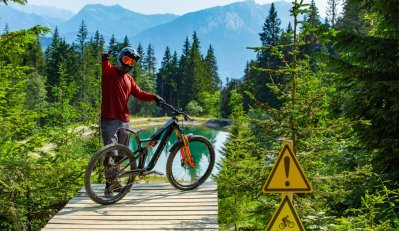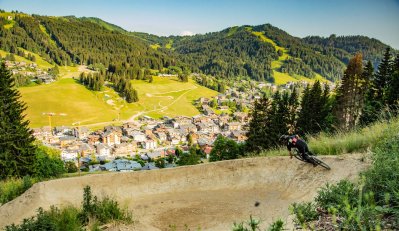We know Chris Kilmurray as personal trainer and coach to some of the worlds best bike riders. Greg and Killian Callaghan, Tahnee and Kaos Seagrave, Katy Winton, Kade Edwards, Charlie Harrison, Thomas Esteque and Reece Wilson are amongst many others on his roster.
These athletes are working with Chris year round on an incredibly detailed and focused level to make them the best athletes they can possibly be. It's an infinitely detailed and organic subject. You only need to give Point1 a follow on Instagram to see the level to which he takes this detail and his own learning. Practicing what he preaches, Chris has to be one of the fittest and energetic individuals we've met in this sport. Everything in his life is dedicated to his craft, self improvement and the improvement of his athletes.
In the woods with Point1 Athletic
Point1 Priniciples
The driving idea behind Chris' methods is teaching athletes how to train.
Coaching at this level is far more advanced than to simply keep your pedals level in a corner and eyes up. Think in terms of planning, how to plan and how that will help you become as good a racer as you can be, unleashing your potential.
It's a mindset that is derived from every decision you make. A human body can't expect to be mentally and physically prepared to ride at the pointy end of a high level race field if it stays up till 1am watching Netflix drinking whisky, don't eat breakfast and need a can of Red Bull to motivate morning sit ups. Equally it is about more than just hitting the gym or riding more road bike, these things are important, but it's the focus and level of detail and commitment you are prepared to put in that will realise your goals.
You get the idea.
The approach is to empower the individual, not tell them what to do do at every corner. How to approach a session at home, in the gym, on the trails or practice at a race. Your body kinematics need to be operating at their maximum potential to allow you to achieve the best possible results, and it's not necessarily working hard only that's going to get you there, it's working smart.
An open mind resolves these questions quickly when you understand that many factors are linked to together.
Line choice, braking points, where to pedal and in what gear are of course key on the trail. Before this is considered you should have the bike setup in a manner that is not only comfortable or familiar for you, but understand what that setup can achieve. Can you brake there? Do you know where your tyres will grip?
The same applies to your body. You want the bike to be on that line, but does your upper body strength allow you to do that? Should you put in that blast on the pedals here or save the energy as you know you will need it later on?
You maybe thinking by now, stop puzzling and just ride! You'd have a point. Chris himself says that the best way to get quick on a bike is to ride it as much as possible. But we are talking about harnessing speed and translating it to results. After all if you were the next Josh Bryceland then we'd have heard of you by now.
To better understand this methodology, as we are not professional athletes at MTB Beds, (well, Fergus is but I am definitely not) I took some time with Chris in the steeps of Morzine to talk about his approach.
Focusing on a 200m stretch, we asked Chris to treat the session like a session of our Spring Camps.
A snap shot session all about the approach to race practice, how to maximise your opportunity to go quickly, in as little time as possible.
A simple concept, ride a section 3 times;
- Ride it blind. As you normally would, as fast as you wish. You will likely make mistakes, understand where they are, where you felt slow, fast, out of shape or struggles to carry speed, where did you apply too much effort for little reward?
- Cruise fast. Take the section or trail at a more relaxed pace. keeping speed to enable traction and flow, but a more considered pace to spot the areas where you could brake less, go high, pedal less or more and visualize your fastest run.
- Ride fast. Hit the same section as fast as possible applying what you've learned the previous two runs.
This sounds so straight forward and obvious but many racers will not do it. A method that can be applied at home on a 100m stretch like here, or on a longer trail, even the whole thing. The key here is not just doing it mindlessly. Appreciating the nuance of where you can improve. A complete understanding of where you can put your bike and body, how you can do that and if you can do that.
Have you given yourself every opportunity to go fast, to make that corner, to get up on that high line, every exercise and decision you make are inextricably linked to each other. That stretch that allows the hips to open fully to persuade the bike to where you want it to go, only possible if you understand in that millisecond why you want it to go there.
It's surprising how this approach from Chris and direct contact with him opens your mind and infact presents more questions at first. This is when you begin to realise you cannot truly teach someone to be a better bike rider in afew 1 hour sessions.
The Session
Chris first asks me to ride the section 'blind'. To be honest i know the trail but i ride faithfully to not knowing it, following the obvious line to me at a reasonable pace. Straight away i slip onto a lower line in a corner and slip my chain getting a pedal in to keep my speed up. Further down i make a similar mistake and lose the aid of the hill i had on my side, dropping low and losing speed.
We discuss. Chris has some great analogies such as prospective control of action. A coffee cup for example;
You see the cup, you know in your mind how much that cup will weigh so you know how much force to use when picking it up. If you see steam coming from the cup you would be right to assume there is liquid inside and so therefore that force would change. These are micro decisions that you aren't aware you are making. The point to this seemingly irrelevant paragraph is to making the decisions you take on the trail as reactive and natural as this, so your mind can focus the important decisions, react to mistakes and focus.
We ride the section again but slowly. Fast enough so the bike is working but slow enough so your gaze and vision can pinpoint the key trail features that you can interact with or not, to go faster, smoother or straighter. I take the higher lines this time, straightening out a section and opening up another corner in a classic Sam Hill manner, efficient even, but not fast.
The third time i do the same thing but at pace, by now those micro decisions have already been made for me. I know what my bike and body can do so why shouldn't it work toward my limits? It does, Chris takes my old lines to show the difference. It's notable.
I'm left with the feeling that if I had applied myself in this way when i did race, instead of just charging away. How would i have done if i'd applied more than just pedalling more, braking less and risking lines? I used to have the pace but no one ever helped me achieve anything notable with it, least of all myself. I think even subtle changes to my attitude, especially at a younger age when my body was more compliant I could have done more, and certainly enjoyed racing for longer. Would it have garnered results? We'll never know.
You could find out your potential with a week in Finale Ligure with Point1 Athletic. It's a must for any aspiring racer. Invaluable, world class knowledge and technique that has been proven on the world stage. Served up in a package in one of the worlds best riding spots, Finale Ligure.
To inquire contact us below or to find out more click the link!


